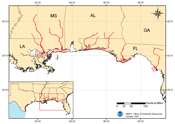Gulf Sturgeon (Acipenser oxyrinchus desotoi)
Status | Taxonomy | Species Description | Habitat | Distribution |
Population Trends | Threats | Conservation Efforts | Regulatory Overview |
Key Documents | More Info
 Gulf Sturgeon (Acipenser oxyrinchus desotoi) Photo: U.S. Geological Survey |
Status
ESA Threatened - throughout its range
Taxonomy
Kingdom: Animalia
Phylum: Chordata
Class: Osteichthyes
Order: Acipenseriformes
Family: Acipenseridae
Genus: Acipenser
Species: oxyrinchus
Subspecies: desotoi
Atlantic sturgeon (Acipenser oxyrinchus oxyrinchus) is another subspecies of A. oxyrinchus.
Species Description
Gulf sturgeon, also known as the Gulf of Mexico sturgeon, are "anadromous" fish, inhabiting coastal rivers from Louisiana to Florida during the warmer months, and the Gulf of Mexico and its estuaries and bays in the cooler months. Sturgeon are primitive fish characterized by bony plates, or "scutes," and a hard, extended snout; they have a heterocercal caudal fin (their tail is distinctly asymmetrical with the upper lobe longer than the lower). Adults range from 4-8 feet (1-2.5 m) in length, females attain larger sizes than males. They can live for about 60 years; usually 20-25 years.
Gulf sturgeon are bottom feeders, and eat primarily macroinvertebrates, including brachiopods, mollusks, worms, and crustaceans. All foraging occurs in brackish or marine waters of the Gulf of Mexico and its estuaries; sturgeon do not forage in riverine habitat.
Gulf sturgeon migrate into rivers to spawn in the spring; spawning occurs in areas of clean substrate comprised of rock and rubble. Their eggs are sticky, negatively buoyant and adhere in clumps to snags, outcroppings, or other clean surfaces.
 Gulf Sturgeon Critical Habitat (click for larger view PDF) |
Habitat
Gulf sturgeon are anadromous: adults spawn in freshwater and migrate into marine waters in the fall to forage and overwinter. Juvenile Gulf sturgeon stay in the river for about the first 2-3 years. Gulf sturgeon return to their natal stream to spawn. Riverine habitats where the healthiest populations of Gulf sturgeon are found include long, spring-fed, free-flowing rivers, typically with steep banks, a hard bottom, and an average water temperature of 60-72° F. Gulf sturgeon initiate movement up to the rivers between February and April and migrate back out to the Gulf of Mexico between September and November.
In 2003, NMFS and the USFWS jointly designated Gulf sturgeon critical habitat; 14 geographic areas from Florida and Louisiana were included encompassing spawning rivers and adjacent estuarine areas.
 Gulf Sturgeon Range Map (click for larger view PDF) |
Distribution
Gulf sturgeon are found in river systems from Louisiana to Florida, in nearshore bays and estuaries and in the Gulf of Mexico.
Population Trends
Total number of mature individuals throughout their range is unknown. However, among coastal rivers of the Gulf of Mexico, the Suwannee River supports the most viable subpopulation, which was estimated at 7,650 adults (Sulak and Clugston 1999). The subpopulation estimate for mature Gulf sturgeon in the Choctawhatchee River ranges from 1,700-3,000 fish; estimates in the Apalachicola, Pascagoula and Pearl rivers range between 50-350 fish (Lorio 2000).
Threats
Gulf sturgeon number initially declined due to overfishing throughout most of the 20th century. Habitat loss was exacerbated by the construction of water control structures, such as dams and "sills", mostly after 1950. Other habitat disturbances such as dredging, groundwater extraction, irrigation, and flow alterations also threaten the Gulf sturgeon. Poor water quality and contaminants, primarily from industrial sources, also contribute to population declines.
Conservation Efforts
On September 30, 1991, the Gulf sturgeon was listed as a threatened species under the Endangered Species Act (ESA) (56 FR 49653). In 1995, a recovery/management plan was published for the Gulf Sturgeon. In addition, all U.S. fisheries for the Gulf sturgeon have been closed.
The IUCN Red List of Threatened Species ![]() considers this species "Near Threatened."
considers this species "Near Threatened."
Regulatory Overview
The Gulf sturgeon was listed as threatened under the ESA in 1991. NMFS and USFWS share jurisdiction of this species. In 1995, we completed a joint Recovery and Management Plan [pdf]. In 2003, critical habitat for Gulf sturgeon was designated for 14 geographic areas among Gulf of Mexico rivers and tributaries.
Key Documents
(All documents are in PDF format.)
| Title | Federal Register | Date |
|---|---|---|
| Designation of Critical Habitat | 68 FR 13370 | 03/19/2003 |
| Recovery/Management Plan | n/a | 09/1995 |
| ESA Listing Rule | 56 FR 49653 | 09/30/1991 |
- U.S. Fish and Wildlife Service Daphne Field Office Gulf Sturgeon Information
- U.S. Fish and Wildlife Service Gulf Sturgeon Species Profile
- U.S. Geological Survey Gulf Sturgeon Facts
- Florida Fish and Wildlife Conservation Commission, Fish and Wildlife Research Institute: Facts About Gulf Sturgeon

References
- Lorio, W. 2000. Proceedings of the Gulf of Mexico sturgeon (Acipenser oxyrinchus desotoi) status of the subspecies workshop. Mississippi State University, Stennis Space Center, MS.
- Sulak, K.J. and Clugston, J.P. 1999. Recent advances in life history of Gulf of Mexico sturgeon, Acipenser oxyrinchus desotoi, in the Suwannee River, Florida, USA: a synopsis. Journal of Applied Ichthyology 15:116-128.